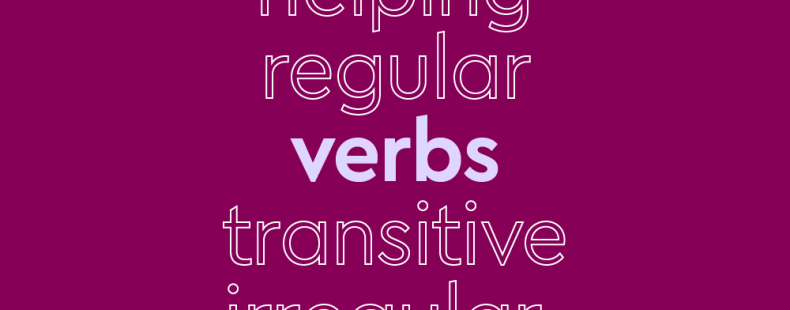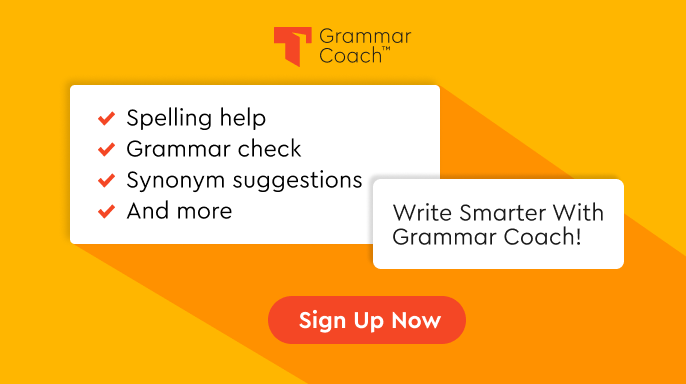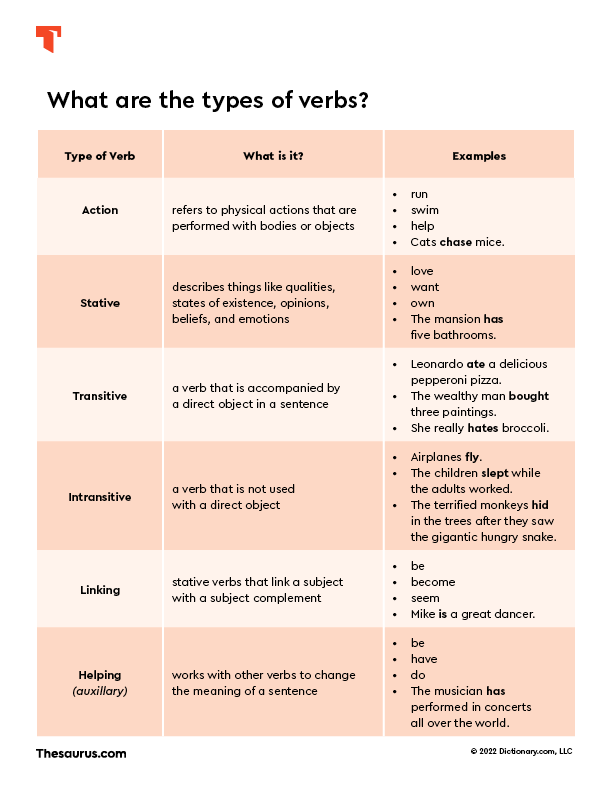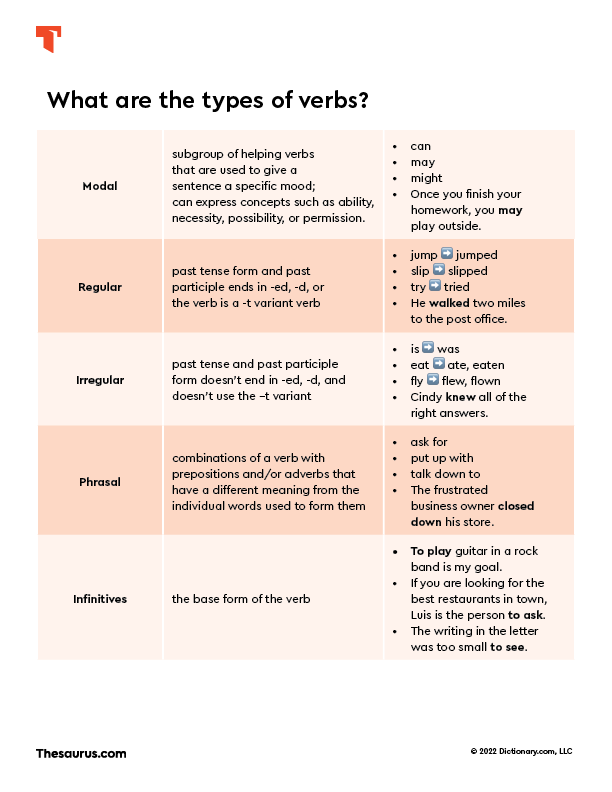On an average day, a lot of things can happen: people go to work. Kids study in school. Animals hunt for food. Friends talk to each other. All of these sentences express basic ideas about everyday events. However, we can also use sentences to express more complicated ideas: citizens can own property. People will chase their dreams to get what they want. Both our simple sentences and complex sentences have something in common: they all use verbs.
Verbs are very important in grammar, and we actually use many different types of verbs when we talk about what things do or how things are. Because they do so much for us, it is only fair that we take the time to learn a little more about verbs and some of the common types of verbs used in English.
What is a verb?
When we write sentences or clauses, we need to include a verb. What is a verb? A verb is a word that we use to refer to actions (what things do) and states of being (how things are). For example, the words describe, eat, and rotate are verbs. As you are about to see, verbs come in a lot of different types that don’t all behave the same way. When using proper grammar, it is important that you use verbs correctly. So, we are going to explore the many different types of verbs that we use and how to successfully use them to create great, clear sentences.
Types of verbs
We are going to explore 11 different types of verbs. Because every type deserves some attention, we won’t be going into too much detail on each type. If you want to learn more than what is covered here, you’re in luck. Listed below are each of the 11 types of verbs we are going to look at and a link to an article entirely focused on that specific type of verb.
- Action verbs
- Stative verbs
- Transitive verbs
- Intransitive verbs
- Linking verbs
- Helping verbs (also called auxiliary verbs)
- Modal verbs
- Regular verbs
- Irregular verbs
- Phrasal verbs
- Infinitives
1. Action verbs
Action verbs, as their name says, are used to refer to actions. These can refer to physical actions that are performed with bodies or objects, such as jump, hit, or sing, or mental actions that we use our brains to perform, such as think, consider, or memorize. Most verbs you will find are action verbs.
List of action verbs
- run
- swim
- help
- ignore
- believe
Examples of action verbs in a sentence
Each of these sentences uses action verbs. You’ll see that each verb is referring to a physical or mental action.
- I work at a factory.
- Cats chase mice.
- We listened to the woman’s amazing story.
2. Stative verbs
Unlike action verbs, stative verbs refer to conditions or states of being. Generally speaking, we use stative verbs to describe things like qualities, states of existence, opinions, beliefs, and emotions. When used in a sentence, stative verbs do not refer to actions. It is important to know that some verbs can be used as either action or stative verbs depending on their meaning in the sentence. We are less likely to use stative verbs in the continuous verb tenses.
List of stative verbs
- love
- want
- own
- have
- resemble
Get to know the stative verb have even better with this examination of has vs. have.
Examples of stative verbs in a sentence
These sentences all use stative verbs. You’ll notice that none of these verbs refer to actions.
- The mansion has five bathrooms.
- Allie loves her younger sisters.
- My car needs an oil change.
3. Transitive verbs
A transitive verb is a verb that is accompanied by a direct object in a sentence. The direct object is the noun, pronoun, or noun phrase that is having something done to it by the subject of the sentence. Both action and stative verbs can have direct objects, which means they can both be used as transitive verbs.
Examples of transitive verbs in a sentence
The following sentences all contain examples of transitive verbs. As you read each one, consider what the direct object of the sentence is.
- Leonardo ate a delicious pepperoni pizza.
- The wealthy man bought three paintings.
- She really hates broccoli.
4. Intransitive verbs
The opposite of a transitive verb is an intransitive verb. A verb is an intransitive verb if it is not used with a direct object. Remember, only nouns, pronouns, and noun phrases can be direct objects. Prepositional phrases, adjectives, and adverbs cannot be used as direct objects. Once again, both action and stative verbs can be used as intransitive verbs.
Examples intransitive verbs in a sentence
Each of these sentences uses intransitive verbs. Look carefully and you will see that none of these sentences have direct objects.
- Airplanes fly.
- The children slept while the adults worked.
- The terrified monkeys hid in the trees after they saw the gigantic hungry snake.
5. Linking verbs
Linking verbs are a special type of stative verb whose name gives a big clue as to what they do. Linking verbs are used to link a subject with a subject complement. A subject complement describes or identifies the subject of the sentence or clause. Linking verbs can function as intransitive verbs, which do not take direct objects.
List of words used as linking verbs
- be
- become
- seem
- appear
- grow
Examples of linking verbs in a sentence
In each of the following sentences, linking verbs are used to link a subject with a subject complement.
- Mike is a great dancer.
- That gold watch looks expensive.
- Suddenly, the mall got really crowded.
6. Helping verbs (auxiliary verbs)
Helping verbs, also called auxiliary verbs, are helpful verbs that work with other verbs to change the meaning of a sentence. A helping verb combines with a main verb in order to accomplish different goals. These include changing the tense of the verb or altering the mood of a sentence.
List of words used as helping verbs
- be
- have
- do
- can
- will
Examples of helping verbs in a sentence
Each of the following sentences uses a helping verb. Take a moment to consider what each sentence is saying and how a helping verb contributes to the meaning of the sentence.
- The musician has performed in concerts all over the world.
- My cat is getting slow in her old age.
- Cheetahs can run incredibly fast.
7. Modal verbs
Modal verbs are a subgroup of helping verbs that are used to give a sentence a specific mood. Each modal verb is used differently, and they can express concepts such as ability, necessity, possibility, or permission.
List of verbs used as modal verbs
- can
- may
- might
- must
- would
Examples of modal verbs in a sentence
The following sentences all use modal verbs to express a certain tone. You’ll see that each sentence would have a different meaning (or wouldn’t make sense) without the modal verb.
- Once you finish your homework, you may play outside.
- We must carefully add two eggs to the mixing bowl.
- I would go to the movies if I wasn’t busy working.
Learn about one certain mood that confuses many: the subjunctive mood.
8. Regular verbs
A verb is considered a regular verb if its past tense form and past participle ends in -ed, -d, or the verb is a -t variant verb. For example, the verb look is a regular verb because both its past tense form and past participle is looked. Sometimes, regular verbs may slightly change spelling. For example, the past tense and past participle of cry is cried.
List of regular verbs
- jump becomes jumped
- slip becomes slipped
- try becomes tried
- sleep becomes slept
- lend becomes lent
Examples of regular verbs in a sentence
Each of the following sentences use regular verbs in either their past tense form or as a past participle.
- He walked two miles to the post office.
- We purchased all of the supplies that we needed for the camping trip.
- Tiffany had noticed something strange about Marcus’s story.
9. Irregular verbs
An irregular verb is a verb whose past tense and past participle form doesn’t end in -ed, -d, and doesn’t use the –t variant. Often, the spelling of these verbs changes dramatically or may not even change at all.
List of irregular verbs
- be becomes am, is, are, was, were, be, being, and been
- eat becomes ate, eaten
- fly becomes flew, flown
- catch becomes caught, caught
- set becomes set, set
Examples of irregular verbs in a sentence
The following sentences use irregular verbs. Despite being used in the past tense or as a past participle, none of these verbs end in -ed, -d, or are a -t variant verb.
- Cindy knew all of the right answers.
- This junky computer has given me nothing but headaches since I bought it.
- The workers took the furniture out of the moving truck.
10. Phrasal verbs
Phrasal verbs are combinations of a verb with prepositions and/or adverbs that have a different meaning from the individual words used to form them. For example, the verb shut means “to close,” and the adverb down means “not up” or “in a descending direction.” However, the phrasal verb shut down means to stop the operation of something.
List of phrasal verbs
- ask for
- put up with
- talk down to
- lock up
- cut across
Examples of phrasal verbs in a sentence
The following sentences show how we can use phrasal verbs. Sometimes, we can separate out the words of a phrasal verb and the sentence is still grammatically correct.
- The frustrated business owner closed down his store.
- Dave loves to show off his baseball trophies.
- My mother always told me it is a good idea to put some money away in case of emergencies.
11. Infinitives
Our last type of verb isn’t actually a verb at all—sorry about that! However, infinitives look a lot like verbs because they are derived from them. An infinitive of a verb is identical to the base form of the verb. For example, the infinitive form of the verb open is open. Typically, we use infinitives with the word to in order to form infinitive phrases. Infinitive phrases can be used for a variety of reasons, such as to act like nouns, adjectives, or adverbs.
Examples of infinitive phrases in a sentence
All of the following sentences use infinitive phrases. In order, the infinitive phrases are acting as a noun (nominal infinitive), an adjective (adjectival infinitive), and an adverb (adverbial infinitive).
- To play guitar in a rock band is my goal.
- If you are looking for the best restaurants in town, Luis is the person to ask.
- The writing in the letter was too small to see.
Find out how well you know the types of verbs by taking this quiz!
We think you’ll agree: you need Grammar Coach!
Improve your writing with Thesaurus.com’s Grammar Coach™, which catches grammar and spelling errors and provides Thesaurus-powered synonym suggestions. Using machine learning, this tool can spot the difference between the different verb types, their correct and incorrect uses—and much more!
Start writing smarter today!

















